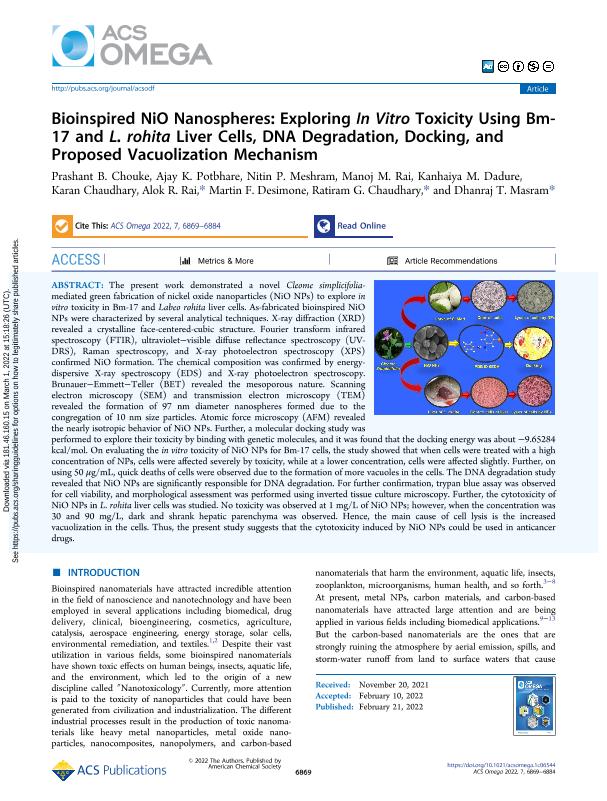Mostrar el registro sencillo del ítem
dc.contributor.author
Chouke, Prashant B.
dc.contributor.author
Potbhare, Ajay K.
dc.contributor.author
Meshram, Nitin P.
dc.contributor.author
Rai, Manoj M.
dc.contributor.author
Dadure, Kanhaiya M.
dc.contributor.author
Chaudhary, Karan
dc.contributor.author
Rai, Alok R.
dc.contributor.author
Desimone, Martín Federico

dc.contributor.author
Chaudhary, Ratiram G.
dc.contributor.author
Masram, Dhanraj T.
dc.date.available
2023-09-04T15:24:55Z
dc.date.issued
2022-02
dc.identifier.citation
Chouke, Prashant B.; Potbhare, Ajay K.; Meshram, Nitin P.; Rai, Manoj M.; Dadure, Kanhaiya M.; et al.; Bioinspired NiO Nanospheres: Exploring In Vitro Toxicity Using Bm-17 and L. rohita Liver Cells, DNA Degradation, Docking, and Proposed Vacuolization Mechanism; American Chemical Society; ACS Omega; 7; 8; 2-2022; 6869-6884
dc.identifier.issn
2470-1343
dc.identifier.uri
http://hdl.handle.net/11336/210373
dc.description.abstract
The present work demonstrated a novel Cleome simplicifolia-mediated green fabrication of nickel oxide nanoparticles (NiO NPs) to explore in vitro toxicity in Bm-17 and Labeo rohita liver cells. As-fabricated bioinspired NiO NPs were characterized by several analytical techniques. X-ray diffraction (XRD) revealed a crystalline face-centered-cubic structure. Fourier transform infrared spectroscopy (FTIR), ultraviolet-visible diffuse reflectance spectroscopy (UV-DRS), Raman spectroscopy, and X-ray photoelectron spectroscopy (XPS) confirmed NiO formation. The chemical composition was confirmed by energy-dispersive X-ray spectroscopy (EDS) and X-ray photoelectron spectroscopy. Brunauer-Emmett-Teller (BET) revealed the mesoporous nature. Scanning electron microscopy (SEM) and transmission electron microscopy (TEM) revealed the formation of 97 nm diameter nanospheres formed due to the congregation of 10 nm size particles. Atomic force microscopy (AFM) revealed the nearly isotropic behavior of NiO NPs. Further, a molecular docking study was performed to explore their toxicity by binding with genetic molecules, and it was found that the docking energy was about −9.65284 kcal/mol. On evaluating the in vitro toxicity of NiO NPs for Bm-17 cells, the study showed that when cells were treated with a high concentration of NPs, cells were affected severely by toxicity, while at a lower concentration, cells were affected slightly. Further, on using 50 μg/mL, quick deaths of cells were observed due to the formation of more vacuoles in the cells. The DNA degradation study revealed that NiO NPs are significantly responsible for DNA degradation. For further confirmation, trypan blue assay was observed for cell viability, and morphological assessment was performed using inverted tissue culture microscopy. Further, the cytotoxicity of NiO NPs in L. rohita liver cells was studied. No toxicity was observed at 1 mg/L of NiO NPs; however, when the concentration was 30 and 90 mg/L, dark and shrank hepatic parenchyma was observed. Hence, the main cause of cell lysis is the increased vacuolization in the cells. Thus, the present study suggests that the cytotoxicity induced by NiO NPs could be used in anticancer drugs.
dc.format
application/pdf
dc.language.iso
eng
dc.publisher
American Chemical Society

dc.rights
info:eu-repo/semantics/openAccess
dc.rights.uri
https://creativecommons.org/licenses/by-nc-nd/2.5/ar/
dc.subject
Bioinspired
dc.subject
NiO
dc.subject
Nanospheres
dc.subject.classification
Nano-materiales

dc.subject.classification
Nanotecnología

dc.subject.classification
INGENIERÍAS Y TECNOLOGÍAS

dc.title
Bioinspired NiO Nanospheres: Exploring In Vitro Toxicity Using Bm-17 and L. rohita Liver Cells, DNA Degradation, Docking, and Proposed Vacuolization Mechanism
dc.type
info:eu-repo/semantics/article
dc.type
info:ar-repo/semantics/artículo
dc.type
info:eu-repo/semantics/publishedVersion
dc.date.updated
2023-07-07T23:05:42Z
dc.journal.volume
7
dc.journal.number
8
dc.journal.pagination
6869-6884
dc.journal.pais
Estados Unidos

dc.description.fil
Fil: Chouke, Prashant B.. Porwal College; India
dc.description.fil
Fil: Potbhare, Ajay K.. Porwal College; India
dc.description.fil
Fil: Meshram, Nitin P.. Nagpur University; India
dc.description.fil
Fil: Rai, Manoj M.. Porwal College; India
dc.description.fil
Fil: Dadure, Kanhaiya M.. No especifíca;
dc.description.fil
Fil: Chaudhary, Karan. University Of Delhi; India
dc.description.fil
Fil: Rai, Alok R.. Porwal College; India
dc.description.fil
Fil: Desimone, Martín Federico. Consejo Nacional de Investigaciones Científicas y Técnicas. Oficina de Coordinación Administrativa Houssay. Instituto de Química y Metabolismo del Fármaco. Universidad de Buenos Aires. Facultad de Farmacia y Bioquímica. Instituto de Química y Metabolismo del Fármaco; Argentina
dc.description.fil
Fil: Chaudhary, Ratiram G.. Porwal College; India
dc.description.fil
Fil: Masram, Dhanraj T.. University Of Delhi; India
dc.journal.title
ACS Omega
dc.relation.alternativeid
info:eu-repo/semantics/altIdentifier/url/https://pubs.acs.org/doi/10.1021/acsomega.1c06544
dc.relation.alternativeid
info:eu-repo/semantics/altIdentifier/doi/http://dx.doi.org/10.1021/acsomega.1c06544
Archivos asociados
